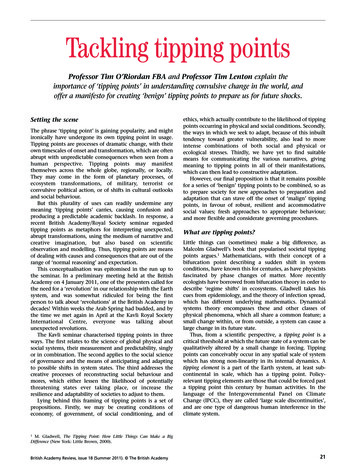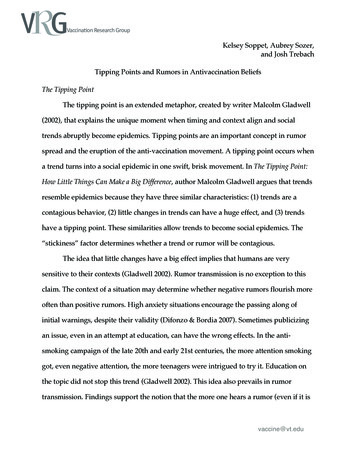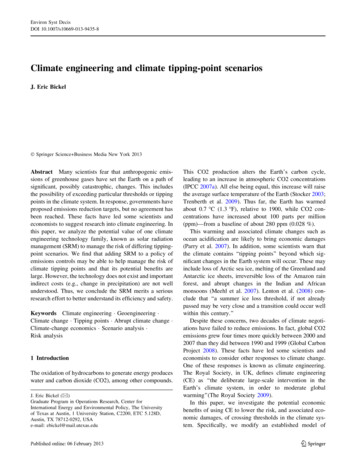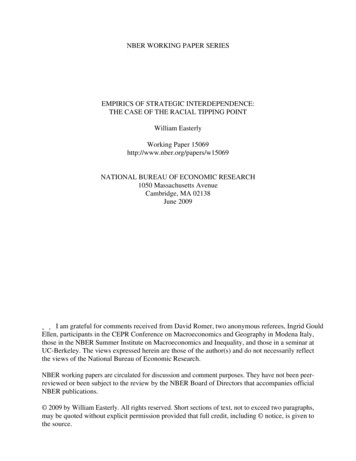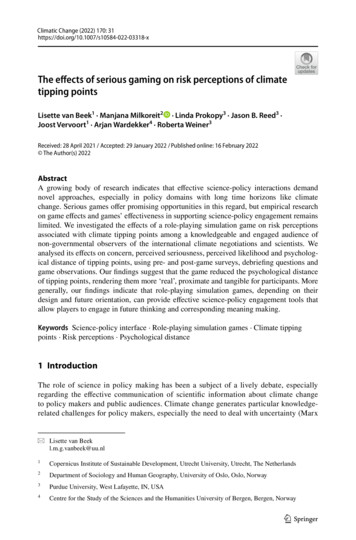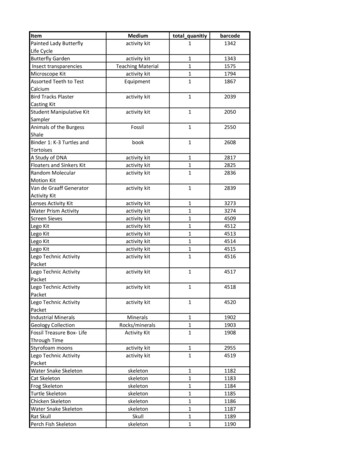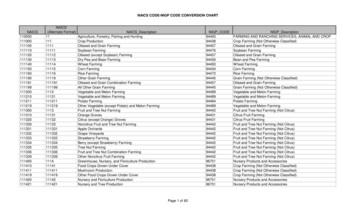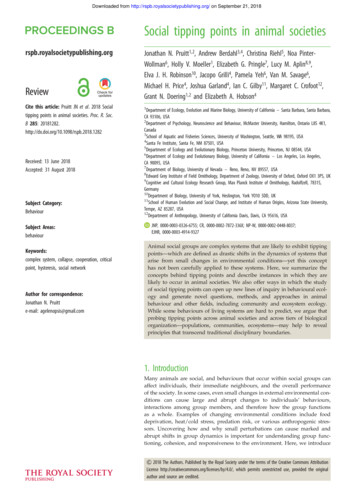
Transcription
Downloaded from http://rspb.royalsocietypublishing.org/ on September 21, 2018Social tipping points in animal societiesrspb.royalsocietypublishing.orgReviewCite this article: Pruitt JN et al. 2018 Socialtipping points in animal societies. Proc. R. Soc.B 285: eceived: 13 June 2018Accepted: 31 August 2018Subject Category:BehaviourSubject Areas:behaviourKeywords:complex system, collapse, cooperation, criticalpoint, hysteresis, social networkAuthor for correspondence:Jonathan N. Pruitte-mail: agelenopsis@gmail.comJonathan N. Pruitt1,2, Andrew Berdahl3,4, Christina Riehl5, Noa PinterWollman6, Holly V. Moeller1, Elizabeth G. Pringle7, Lucy M. Aplin8,9,Elva J. H. Robinson10, Jacopo Grilli4, Pamela Yeh6, Van M. Savage6,Michael H. Price4, Joshua Garland4, Ian C. Gilby11, Margaret C. Crofoot12,Grant N. Doering1,2 and Elizabeth A. Hobson41Department of Ecology, Evolution and Marine Biology, University of California – Santa Barbara, Santa Barbara,CA 93106, USA2Department of Psychology, Neuroscience and Behaviour, McMaster University, Hamilton, Ontario L8S 4K1,Canada3School of Aquatic and Fisheries Sciences, University of Washington, Seattle, WA 98195, USA4Santa Fe Institute, Santa Fe, NM 87501, USA5Department of Ecology and Evolutionary Biology, Princeton University, Princeton, NJ 08544, USA6Department of Ecology and Evolutionary Biology, University of California – Los Angeles, Los Angeles,CA 90095, USA7Department of Biology, University of Nevada – Reno, Reno, NV 89557, USA8Edward Grey Institute of Field Ornithology, Department of Zoology, University of Oxford, Oxford OX1 3PS, UK9Cognitive and Cultural Ecology Research Group, Max Planck Institute of Ornithology, Radolfzell, 78315,Germany10Department of Biology, University of York, Heslington, York YO10 5DD, UK11School of Human Evolution and Social Change, and Institute of Human Origins, Arizona State University,Tempe, AZ 85287, USA12Department of Anthropology, University of California Davis, Davis, CA 95616, USAJNP, 0000-0003-0326-6755; CR, 0000-0002-7872-336X; NP-W, 0000-0002-0448-8037;EJHR, 0000-0003-4914-9327Animal social groups are complex systems that are likely to exhibit tippingpoints—which are defined as drastic shifts in the dynamics of systems thatarise from small changes in environmental conditions—yet this concepthas not been carefully applied to these systems. Here, we summarize theconcepts behind tipping points and describe instances in which they arelikely to occur in animal societies. We also offer ways in which the studyof social tipping points can open up new lines of inquiry in behavioural ecology and generate novel questions, methods, and approaches in animalbehaviour and other fields, including community and ecosystem ecology.While some behaviours of living systems are hard to predict, we argue thatprobing tipping points across animal societies and across tiers of biologicalorganization—populations, communities, ecosystems—may help to revealprinciples that transcend traditional disciplinary boundaries.1. IntroductionMany animals are social, and behaviours that occur within social groups canaffect individuals, their immediate neighbours, and the overall performanceof the society. In some cases, even small changes in external environmental conditions can cause large and abrupt changes to individuals’ behaviours,interactions among group members, and therefore how the group functionsas a whole. Examples of changing environmental conditions include fooddeprivation, heat/cold stress, predation risk, or various anthropogenic stressors. Uncovering how and why small perturbations can cause marked andabrupt shifts in group dynamics is important for understanding group functioning, cohesion, and responsiveness to the environment. Here, we introduce& 2018 The Authors. Published by the Royal Society under the terms of the Creative Commons AttributionLicense http://creativecommons.org/licenses/by/4.0/, which permits unrestricted use, provided the originalauthor and source are credited.
Downloaded from http://rspb.royalsocietypublishing.org/ on September 21, 2018BAYYT2T1ditionental conmnoirvneture)(temperaFigure 1. A hysteresis window between an environmental condition (e.g.temperature) and group behaviour (e.g. degree of infighting). This figureis modelled after a study on within-group conflict in response to heatstress in social spiders. Groups that have been in an agitated state (red)tend to remain agitated, whereas calm groups (blue) tend to remaincalm. Therefore, there exists a set of intermediate environmental conditions(T1 , T , T2) where a group can be either calm or agitated depending onits historical dynamics. In the lower panel, solid lines represent stable equilibria states and the shaded regions show their basins of attraction. The dashedline is an unstable equilibrium, which demarks the boundary between thebasins of attraction. The upper panels (A– E) provide an alternate abstractionof this system: for a given environmental condition, the group response tendsto a low point on the ‘landscape’. The bottoms of the troughs in the upperpanels are therefore stable equilibria and correspond to the locations of thesolid red and blue lines in the lower panel (see ‘Y’ label for an example).Tipping points occur when a stable equilibrium (solid line/trough) collideswith an unstable equilibrium (dashed line/peak) and is eliminated—atthis point the system transitions suddenly to the alternate remaining equilibrium. In this system the tipping points are at T1 (when the system is in theagitated state and temperature is decreasing) and at T2 (when the system isin the calm state and temperature is increasing).environmental parameter), and this shift is conspicuouslyabrupt, which is diagnostic of social tipping points (figure 2).2. Core concepts of social tipping pointsThere are several concepts that are needed to apply the conceptual framework of tipping points to social systems. Wedescribe these concepts here using an example. Socialspider colonies exhibit a tipping point towards violentinfighting in response to heat stress (figure 1) [14]. Whencolonies have been in cool temperatures (less than 278C)they are generally calm and cooperative but transition intoinfighting at higher temperatures (greater than 318C). However, when the temperature cools, colonies do notimmediately return to their calm state upon reaching the critical 30–318C, but require much cooler temperatures (less than27– 288C) to return to their prior state. Thus, at an equivalenttemperature, say 298C, a colony can be characterized by highlevels of infighting or calm cooperation, depending on its history. Notably, the shift between calm and agitated colonybehaviour is mediated by temperature (the external(a) Behavioural states and environmental parametersMany animal social systems are capable of exhibiting multiple qualitatively distinct states. We refer to these asbehavioural states, such as the calm (blue) and agitated (red)colony states in the spiders in figure 1. The behaviouralstate expressed is dictated by the system’s dynamics as wellas environmental parameters such as humidity or temperature(figure 1, x-axis) and internal parameters such as metabolicor cognitive factors. For social tipping points, we deemforces acting from outside the group to be environmentalparameters and forces emerging from within the group asinternal parameters.Environmental parameters can be abiotic or biotic. Moststudies on tipping points have examined abiotic drivers[3,6,14], whereas relatively few have examined biotic drivers,social or otherwise. Abiotic parameters include temperature,Proc. R. Soc. B 285: 20181282Tipping points are drastic shifts in the behaviour of systemsas a result of small changes to the environment. In ecology,tipping points are often referred to as ecological thresholds[5– 7]. For example, a small change in the temperature of alake can lead to large shifts in the composition of the lake’scommunity. Other commonly cited examples of ecologicaltipping points include sudden shifts in species dominanceor population collapse [8,9].Similarly, in a social context, social tipping points occurwhen small changes to the physical or social environmentresult in qualitative changes to group behaviour or dynamics[10]. In animal societies, tipping points could be used toexplain social transitions such as the onset of collective movements, shifts in group behaviour from calm to agitated states,the emergence and disappearance of wars between neighbouring societies, the formation or disbandment ofcooperation, or the diffusion of new innovations. Forinstance, African desert locusts rapidly shift betweentheir little-observed solitary state to a swarming plague phenotype. The transition between these states is densitymediated and catalysed by positive feedback loops betweenpopulation density, individual activity level, and serotoninmediated gregariousness [11–13]. Thus, small changes inpopulation density can cause large and abrupt changes inboth individual state and group dynamics in these locusts.EDCrspb.royalsocietypublishing.org(a) What are tipping points?2enspoe s n)p r sioou e sgr a ggr(the idea of tipping points, which have been used to betterunderstand the dynamics of complex systems in many fields.The term tipping point was first used in the academic literature by Morton Grodzins to describe racial segregationin US cities [1]. Ecologists and climate scientists have sinceused tipping points to better understand shifts in lake eutrophication [2], forest-grass transitions [3], and coral reef states[4]. Although the idea of tipping points has been used as apopular analogy for sudden changes in social systems, theconceptual framework underlying tipping points has notbeen widely applied to questions in behavioural ecology. Inthis article we explain what tipping points are, how theyhave been studied in other contexts, and how the tippingpoint framework could provide new insights and predictivepower into the study of animal behaviour.
Downloaded from http://rspb.royalsocietypublishing.org/ on September 21, Figure 2. Social tipping points are characterized by an abrupt change in behaviour state caused by small changes in environmental parameters. Here, groups ofterritorial damselfish (brown fishes) may respond with vigilance and inspection (top image) towards intruders or not (bottom image) depending on whether food islimited. One sign of a possible tipping point is a change point in the data, where the data suddenly appear to be nonstationary. In the plot, this is depicted as asudden change in the mean of aggressiveness ( y-axis). If a model for aggressiveness is built for conditions where food supply is low, but then applied to caseswhere food supply is high, the model will have very large error. This reinforces the point that the old model is no longer valid for the new data if a tipping pointhas occurred. The three functions fitted to the identical data above have all been used to estimate the position of tipping points along environmental gradients,though the centre panel reinforces the point that entirely new models may be required to explain system properties before versus after a tipping point.light, precipitation, oxygen levels, pH, aridity, anthropogenicnoise, tides, and terrain [3,6,8]. Biotic parameters can besocial (e.g. the number or collective phenotypes of nearbygroups) or nonsocial (e.g. predation threat, food availability,or presence of parasites/disease). It is worth noting thatmany tipping points may be driven by changes in severalenvironmental parameters, such as the combination of heatand UV exposure. Because of the potential combined effects,it is important to consider to what degree phenomenalike priming, enhanced lethality of multiple stressors, orcross-tolerance affect group behaviour [15– 18]. Multipleinteracting environmental parameters could be groupedinto functionally similar groups based on their properties orbecause of the shared effects that they have on social groups.(b) Attractors and basins of attractionUp to this point we have presented behavioural states as categorical (such as calm and agitated), but behaviours canactually be more fluid. For example, a spider may be slightlyirritated, but not fully agitated. As time progresses, the spidermay become calm or agitated, depending on environmentalparameters. In this example, the categorical states of calmand agitated are referred to as attractors and the set of fluidstates that tend towards these categorical states are theseattractors’ basins of attraction. In figure 1, the solid red andblue lines depict the agitated and calm attractors for arange of environmental parameters (here, temperature). Thelighter shaded areas in figure 1 are the basins of attractionfor these two attractors. For intermediate environmental parameters, two attractors exist. At very low temperatures, thereis only one attractor, the calm state, while at very high temperatures, only the agitated attractor exists. It is important toemphasize that attractors can appear and disappear, dependingon environmental parameters.In some cases, environmentally driven tipping pointsmay be irreversible. For example, events such as the onsetof sex change in sequential hermaphrodites [19], the onsetof epidemic spawning in marine invertebrates [20], or theemergence of sexual alates in social insects [21] can beone-way transitions in behavioural state driven by minorperturbations to environmental parameters. In these cases,the former attractors have vanished as a consequence of thesystem undergoing a tipping point.In addition to the presence and number of attractors, thelandscape of attraction can vary. In figure 1, this is depictedwith the landscape slices above the main figure whichshow how the geometry of the basins of attraction aremodified as environmental parameters change. In eachcase, the blue or red balls indicate the attractors at thebottom of wells symbolizing the basins of attraction. Thesteepness of the walls of these basins of attraction determinethe strength of the feedback mechanisms keeping the systemin a given state—the steeper the walls of the wells, the quickerthe system returns to the attractor state and the more resistantthe state is to noise. When the wells are shallow, the systemreturns to the attractor more slowly and drifts more widelyin response to noise [9,22,23].(c) PerturbationsThere are two fundamentally different ways that a system canbe perturbed. Either the behavioural state or the environmental parameters can be perturbed. To think about theeffect of perturbations to the behavioural state, consider asingle slice of the landscape of attractors in figure 1. Whenthe behavioural state is perturbed, envision the system asone of the coloured balls that are subject to that particularlandscape. If the ball is perturbed enough that it moves toanother basin of attraction then the system undergoes a behavioural state change. However, this kind of perturbationis not technically classified as a tipping point because thetransition was not caused by changes to the external environment. In contrast, when an environmental parameterchanges, the landscape itself changes, which can alter theexistence of attractors and the shapes of their basins of attraction. In figure 1, this is depicted by the series of slicesshowing the landscapes governing the basins of attraction.Proc. R. Soc. B 285: 20181282food supply
Downloaded from http://rspb.royalsocietypublishing.org/ on September 21, 2018(a) How can we recognize tipping points?It can be difficult to recognize that a tipping point hasoccurred from observational data alone, especially if observations are noisy. However, there are some signatures oftipping points that one may recognize in their system of interest. One signature is that when a tipping point occurs, smallenvironmental changes alter system dynamics so that previous models explaining the behaviour of the system builtunder one regime are no longer predictive when the regimehas shifted. Although there are many reasons a model maynot explain data, assuming an equilibrium state, a potentialindication of a tipping point is when a model explainsthe data well under some conditions but then failswhen environmental parameters change. Other possiblesignatures of tipping points include flickering betweenbehavioural states and delayed recovery to prior statesfollowing perturbation [10].(b) Are critical points and tipping points equivalent?While the terms tipping point and critical point are often usedinterchangeably in the literature, there are distinctions.Loosely, a critical point occurs when the stability of attractorschanges. Tipping points require a quantifiable change inbehavioural state as a result of minor changes in environmental parameters. This makes all tipping points criticalpoints, but not all critical points tipping points. For example,a system moving through a critical point could have a continuous behavioural state as environmental parameterschange, but a system with a tipping point would have a discontinuity in the behavioural state as a function of theenvironmental parameters (figure 2).(c) Is there hysteresis?The existence of multiple behavioural states allows for thepossibility of hysteresis—a concept often linked to tippingpoints in the literature [25– 27]. Hysteresis is a system’s lackof reversibility as environmental parameters are varied. Asystem exhibits hysteresis if reverting the environmental parameters in a system that has passed through a tipping pointto the parameters immediately preceding the change does not(d) Are there early warning signs of tipping points?One of the most challenging aspects of tipping points isanticipating when and where they are likely to occur[22,23,28]. There are two general predictors whose presenceis thought to anticipate an impending tipping point. First,increased variance in a system’s internal dynamics is predicted to warn of an approaching tipping point [9,29].Destabilized dynamics, large swings and oscillations, or flickering between states all potentially convey that the feedbackthat keeps a system at one attractor state is weakening, whichallows the system to wander farther from the attractor.Second, the speed of recovery to baseline conditions is predicted to decrease when a system is approaching its tippingpoint [2,9]. This is because the strength of the feedback thatmaintains systems in one state decreases as a system movestoward a tipping point, and therefore the rate of recovery isslower. In behaviour, there may be other warning signsbased on individual-level characteristics, or early behaviouraloutcomes prior to more dramatic state shifts.4. Applying tipping points to animal societies(a) What can be learned?Tipping points can inform our understanding of animalsocieties in a variety of ways. First, documenting tippingpoints aids our ability to forecast dramatic state shifts inanimal behaviour [29]. This, in turn, can help us to predicthow societies will change in response to environmental parameters, which is required for conservation [30–32].Second, tipping points convey information about societies’comparative sensitivity to environmental parameters. Thepresence of abrupt tipping points, pronounced hysteresis,an inability to recover to baseline dynamics following perturbation, and large differences in behavioural states all conveythat the internal dynamics driving a system are strongly nonlinear. Additionally, in the presence of tipping points, asystem’s responsiveness to the environment could appeardeceptively small, save for the regions immediately aroundthe tipping point. Many systems therefore may appear deceptively stable, unless one specifically interrogates the limitedset of conditions that trigger the system to tip. Third, scrutinizing tipping points and their adaptive function may shedlight on how social groups are capable of incredible behavioural flexibility. For example, there is evidence thatsocieties may self-organize or evolve to keep themselvesnear tipping points, so that they can respond dynamicallyto new information or environmental challenges [27,33] andpotentially maximize the adaptive advantages of both orderand disorder [33]. Fourth, scrutinizing tipping points acrosstiers of biological organization may help us to determinewhether there are generalizable features about their4Proc. R. Soc. B 285: 201812823. Tipping points: frequently asked questionscause the system to revert to the previous behavioural state.For example, once agitated, spider societies require coolingto far lower temperatures to return them to a calm state(figure 1). However, not all tipping points will exhibit hysteresis. Tipping points and hysteresis are important to considerbecause it changes the way that systems should be modelled.In particular, researchers may assume that their systems asreversible in parameter space but, if hysteresis is present,this is not the case.rspb.royalsocietypublishing.orgThe society moves through a tipping point when a smallchange to environmental parameters results in a drasticenough modification to the attractor landscape that thesociety is now in an alternative basin of attraction. A criticaldifference between the two types of perturbations is thatwhen a tipping point occurs, the underlying dynamics havechanged and thus the previous regime’s models and dataare no longer effective in describing the new regime.Attractor states are not necessarily advantageous or disadvantageous. For example, social groups might proceedfrom a relatively calm cooperative stable state to disbandment or collapse due to infighting or cheating [14,24].However, a system might also switch between two statesthat perform equally well. The alternative states might evenbe part of a system’s life history. Thus, attractor states arenot necessarily evolutionary stable states (ESS) nor adaptivepeaks in a fitness landscape, nor do they necessarily havenegative consequences for social groups.
Downloaded from http://rspb.royalsocietypublishing.org/ on September 21, 2018535alert marmosetsreturn tolow risksocial state4ocelot attackpredation riskFigure 3. A hysteresis window depicting the relationship between group activity level ( y-axis) in association with contrasting levels of predation risk (x-axis). At lowlevels of predation groups engage in social interactions that heighten group activity (1) but also distract groups from detecting small to moderate levels of predationrisk (2). However, at some increased level of predation risk groups decrease activity and become vigilant (3), and extreme levels of risk will cause groups to go intohiding and cease activity (4). As risk dissipates, groups require a much lower level of risk to resume social activity (5).dynamics that bridge tiers of biological organization. Fifth,knowledge of tipping points can help guide researchersas to when a new modelling paradigm may be necessary topredict system behaviour.(b) How can social properties affect tipping points insocial systems?Many social properties could influence whether tippingpoints occur in a society. These include relatedness andgroup size, presence of keystone individuals, within-group behavioural diversity, group social organization, and groups’prior experience. In this section, we present a hypotheticalexample and then use it as a lens to pose how social propertiesmight impact tipping points.Consider a hypothetical situation where the activity levelof a group of marmosets depends on the level of predationrisk (figure 3). When predation risk is low, groups aresocially active and have a chance of entering distractedsocial states. Distracted states may emerge when one individual steals fruit or chases another individual, resulting ina competitive tit-for-tat game. Once initiated, social activitycan keep a group in an active and distracted state despitemild to moderate increases in predation risk. However, ata tipping point, even a distracted group will detect heightened risk, and activity will decrease in favour ofvigilance. Returning back to social activity will then requirea large decrease in predation risk because vigilance rendersa group sensitive to even moderate risk. Thus, under someconditions, whether a group will be active or inactive willdepend on its prior state (distracted versus vigilant), creatinga hysteresis window.(i) Relatedness and group sizeGroup relatedness and size likely influence tipping points.Relatedness has an impact on a variety of social outcomes,including increased prosocial behaviour and decreasedexploitation among group members [34,35]. Thus, social feedback driven by competitive interactions may be less stablebetween relatives [36]. Kin groups may also be more likelyto share information about predation risk even at risk tothemselves, for instance, via alarm calls [37,38]. Group sizeis also likely to impact the above scenario. Increasing groupsize could augment competitive interactions and keep individuals in a distracted state for longer. Larger groups mayalso compete more [39] and this could increase group distraction. Yet, larger groups also have more individuals withwhich to detect changes in the environment and share information [27,40]. The net effect of group size may thereforedepend on the degree to which social interactions impedeindividuals’ probability of detecting risk and the degree ofinformation sharing.(ii) Keystone individualsThe presence of influential individuals impacts social tippingpoints. For instance, the presence of leaders or reconciliatoryindividuals may prevent tit-for-tat feedback loops from everstarting [41,42]. In contrast, the presence of particularlyaggressive, hungry, or bold individuals could increasewithin-group conflict [43], thus changing the environmentalProc. R. Soc. B 285: 20181282group activity2 active groupstate decreasesgroup vigilancerspb.royalsocietypublishing.org1 low risk heightenssocial activity
Downloaded from http://rspb.royalsocietypublishing.org/ on September 21, 2018parameter values that result in a tipping point and the feedback strength that underlies them.(iv) Social organizationThe social structure of our marmoset groups and the space inwhich the interactions occur also likely affect tipping points[29]. In groups that live in or build structures, such as nests,the geometry of these spaces can determine the kinds of interactions that individuals engage in, the degree of competitionamong group members, risk of predation, environmental sensitivity, and so on [47]. Nests also provide some homeostaticbenefits to their residents [48], which will likely impact thesusceptibility of groups to changes in environmental parameters. For groups that live in more open environments,geographical constraints such as rivers, matrix habitat, andlocalized resources such as fruit trees will impact individuals’ position in space and therefore the structure of socialnetworks [49]. Networks, in turn, will shape whetherand how individuals interact and influence each other’sbehaviour [50].(ii) Metabolic tipping pointsA system may pass through a tipping point if environmentalparameters drive individuals into alternative metabolic statesthat affect individuals’ behaviour. For example, excessiveheat can force social ectotherms into collective activityeither to cool themselves, like collective fanning behaviourin honeybees [54], or to evacuate a nest site entirely. Anotherpotential example of a metabolic tipping point is when excessive cold or aridity causes collective huddling to preserveheat and water in small bodied animals [55]. Metabolic tipping points can be additive or synergistic. For instance,collective huddling behaviour may enable groups of homeotherms to remain socially active in environments thatexceed the thresholds of each individual in isolation [56].In contrast, social ectotherms may exhibit a more additiveresponse because constituents cannot share metabolic heat[57]. Other examples of metabolic tipping points can occurbecause of contrasting hunger levels, fat stores, hypoxia,exposure to contaminants, infection status, microbiomes,and so on.(iii) Social or cognitive tipping points(v) Prior experienceWhether or not social groups have previously been exposedto specific environmental parameters will likely impacttheir future tipping points [2,6]. For instance, prior experiencewith anthropogenic noise might prime a marmoset groupand desensitize it to subsequent noise exposure [51]. In therelated concept of cross-tolerance [52], experience with onestressor can increase the system’s resistance to other stressors.The predicted outcome is similar to that of priming but differs in that stressors can appear interchangeable. A finalstressor query is whether the social context of prior experience matters. For instance, the effects of prior experiencemay depend on whether individuals acquired their experience in isolation, in a group setting, or in a group settingthat differs from their present group. The effects of suchexperiences will likely not be equivalent.Tipping points can also be mediated by social or cognitiveparameters, which arise because individuals’ perception oftheir environment has changed. For instance, cautious orflight-prone behaviour in one group member might catalysethat behaviour in another individual [58]. Alternatively,observer individuals may copy the successful foraging strategies of innovative group mates [59] or the migration routesof older individuals [42,60]. The key ingredient for these transitions is that actors are capable of observing theirenvironment, and then adjusting their behaviour accordingly.In principle, social or cognitive state transitions can occur atdifferent social scales as well. For example, each individualmay independently learn about its environment, and therefore, the group’s behaviour changes as the sum
2. Core concepts of social tipping points There are several concepts that are needed to apply the con-ceptual framework of tipping points to social systems. We describe these concepts here using an example. Social spider colonies exhibit a tipping point towards violent infighting in response to heat stress (figure 1) [14]. When
